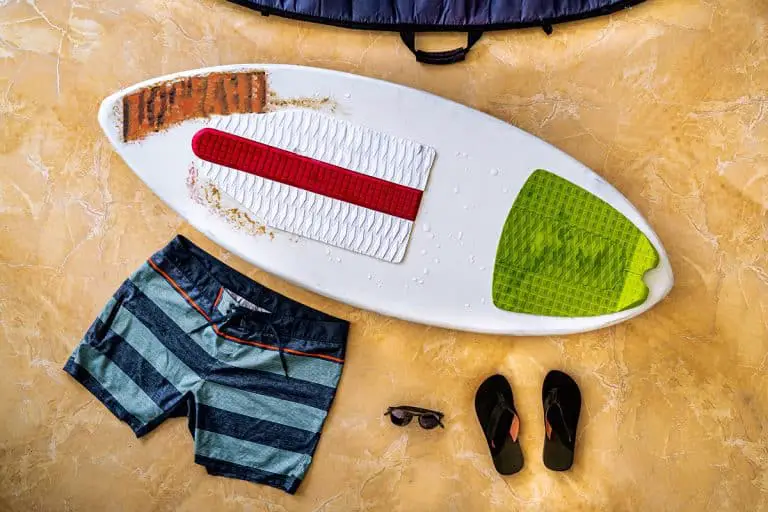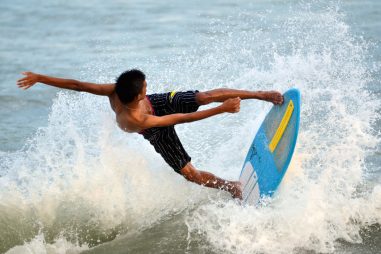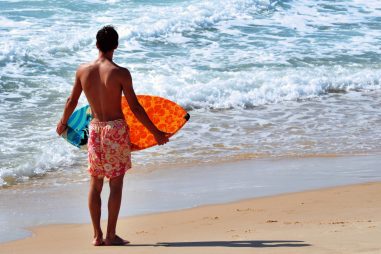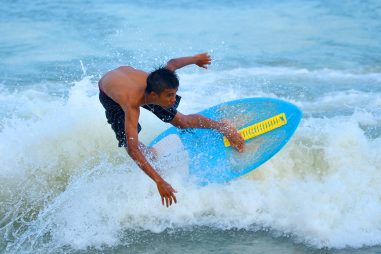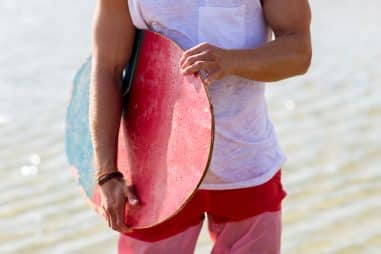Skimboarding is slowly becoming a popular board sport all over the world. It is sort of a combination of the fundamentals of surfing, skateboarding, and even snowboarding. It is also a very no-fuss sport as you would just need a skimboard. To get the most out of your skimboard, you would need to know how to wax it properly and what wax to use. You should also learn the value of traction pads and how they can help you progress in the sport.
Should I Wax Skimboard?
It is definitely recommended to wax your skimboard. Like all other sports that use a board (such as skiing, skateboarding, surfing, or snowboarding), a generous amount of wax would help you ride your board better. Even if you have an old board or a new one, it is still best to use wax to use your board to its fullest.
There are many different variants of waxes, and some of them may be or may not be used in skimboards. Since board sports have a wide range (some can be done on land while the others are performed in water), different waxes also have varying effects depending on the board.
Why Do You Wax a Skimboard?
You should wax your skimboard because it helps keep your feet firmly planted on the surface of your board. Applying the wax is a great way to keep your feet from sliding around, especially when you hit the waves. Make sure to apply a generous coating of wax before your rush off into the ocean.
Waxing your board is a step that you should never skip. It will keep you safe because the wax will increase the grip that your feet have on the skimboard. It would lessen the likelihood of you slipping off and hurting yourself in the process.
Which Side of the Skimboard Do You Wax?
Generally, professional skimboarders highly recommend waxing the top of your board. There are also those who advocate for waxing the bottom of your board. There are really no strict rules on which side to put wax in, but waxing the bottom of a skimboard has been a topic of debate for skimboarding enthusiasts for many years now.
Whether you believe in waxing the bottom of your board, you should never skip waxing the top. This is the side that clearly needs the help of wax to increase the traction between your feet and the board.
Do You Put Wax on the Top or Bottom of a Skimboard?
It is recommended to apply wax on top of your skimboard before you even hit the water. This is a step that you should never miss because the wax will help keep your feet from slipping off of the surface of the board. Because your feet will be firmly planted on the board (thanks to the wax), the likelihood of you being hurt goes significantly down.
While not recommended for beginners, you can also wax the bottom of your board. Or you can also choose not to do this step. Waxing the bottom of your board is mainly depending on the preference of the skimboarder. As your skills progress, you can decide for yourself if there is a need for you to wax the bottom of your board or not.
Do You Always Wax the Top of a Skimboard?
You should remember to ALWAYS wax the top of your skimboard. You should never skip this step for your safety. Waxing your board is very important because the wax will keep you from sliding off of your board.
Choose a sticky surf wax and apply it generously on the top of your skimboard. The wax will significantly increase the traction between your feet and the board. If you skip on waxing your board, it will be very slippery once you are in the water. Skimboarding sans the wax may result in accidents.
Should I Wax the Bottom of My Skimboard?
There are no rules keeping you from waxing the bottom of your skimboard. However, it is not really advisable, nor is it being done by a lot of skimboarders. It is especially not as recommended for beginners and those just dipping their toes in the sport.
While it is not a need to wax the bottom of your skimboard, doing this has its benefits (albeit very little). For one, if you apply the suitable wax on the bottom of your board, this may help you increase your speed but only a little. There are also other improvements on the way your skimboard glides across the water; however, these may be very minimal, and a beginner skimboarder may not notice the difference at all.
Do You Need to Wax the Bottom of a Skimboard?
You don’t actually need to wax the bottom of your board, and often it is a step that skimboarders tend to skip, especially the beginners. This is because it does little to improve the way your skimboard moves across the water. However, since there are no rules keeping you from waxing your board, you can choose to do it.
If you decide on waxing the bottom of your board, you should remember to never use surf wax. Surf wax, especially those made extra sticky, will make it harder for your board to glide smoothly in the water. This is because surf wax when used on the top side of your board, helps in increasing the grip of your feet to keep you from sliding. Applying surf wax on the bottom side and then going in the water may cause you injuries because the surf wax will keep your skimboard from moving smoothly.
Instead of surf wax, you can choose to apply Speed Wax or Eelsnot not instead. You can also select other slippery waxes to help speed your board up a little. However, keep in mind that whichever wax you choose to use, the improvements may be minimal and barely noticeable.
How Often Should I Wax My Skimboard?
Some people choose to apply wax every time they hit the waters. Meanwhile, others only apply the wax whenever they feel that the grip has lessened. There is no strict rule on when you should apply wax on your board because most people just do it by feel. As you progress in the sport, you can definitely tell when it’s time to top up on the wax or when to completely re-wax it.
Re-waxing your skimboard, on the other hand, is generally done every 3 or 6 months or 2 to 4 times a year, depending on several factors. These factors include the following:
- Water temperatures: The wax on the top of your board should also change along with the seasons. Since a new season brings in a new water temperature, the wax to use should complement the current season. It is not advisable to use just one kind of wax for all four seasons because the wax that you applied during the summer will harden over the winter. Conversely, the wax that you apply during the winter will loosen up and melt during the summer. However, you should consider that the change in water temperature happens a little later than the actual change in season. As such, most professional skimboarders advise you to re-wax your board twice a year.
- Wax clumps: If you continue to top up the wax on your board, sooner or later, large chunks of wax will develop on top of your skimboard. Large clumps of wax may be dangerous for you because they can be uncomfortable for your feet. Aside from that, it offers a lot less traction between your feet and the board. When your board does form large chunks, it is not advisable to top it up with more wax. What you need to do is to completely strip off the wax currently on your board. Once you have removed all the wax off, it is now time to apply a new coat on top of your board.
- Wax melts: Keeping your skimboard under the sun or inside the trunk of your car may result in the wax melting. Once the wax cools down, it will most likely reset to its original form. Constant melting and resetting of the wax will make it harder and less sticky because the changes that the wax goes into will change its chemical makeup. While you can apply a new coat of wax to the top of your board, if the melting and resetting happen a lot, it is more advisable to remove all the wax and to apply a fresh layer of wax.
- Color changing: Sun exposure, temperature fluctuations, and sand and debris seeping into your wax will cause it to become yellow. This is a sign that your wax is growing old, and it’s time to remove it and re-wax your board to make it seem brand new again. A new layer of wax will also improve your grip.
- Dirt or Sand: It is not new for sand to cling to the wax on your board, and over time, the sand will press more onto your skimboard, making it nasty and gritty. It is an ancient trick to apply sand into candle wax to increase the grip on your board. However, that trick does not apply now because skimboarders found that their grip on the board got significantly worse the sandier it gets. Wax applied on top of your sandy wax will also not cling properly. So, once your skimboard gets sandy, it is your sign to re-wax it.
What Is the Best Skimboard Wax?
Some of the best surfboard wax brands in the market include Sticky Bumps and Mr. Zogs Sex Wax. Skimboarders often gravitate towards surf wax for their skimboards because they help in increasing your feet’ grip on the board. There are several types of surfboard wax which are cold, cool, warm, and tropical.
Each of these types is designed to be used at a certain water temperature. They go as follows:
- Cold Wax = Temperature 58 degrees Fahrenheit and below (14.44 degrees Celsius and below)
- Cool Wax = Temperatures between 58 and 68 degrees Fahrenheit (14.44 to 20 degrees Celsius)
- Warm Wax = Temperatures between 68 and 78 degrees Fahrenheit (20 to 25.55 degrees Celsius)
- Tropical Wax = Temperatures 75 degrees Fahrenheit and above (23.88 degrees Celsius and below)
Can You Use Candle Wax on a Skimboard?
Using candle wax on a skimboard is a technique that old timers used to do because it was the only type of wax available to them. While there are no rules prohibiting the use of candle wax today, it is not recommended by many, especially when more appropriate wax is out in the market and readily available.
Using candle wax on your skimboard will make the surface slipperier compared to when you use surf wax. Aside from that, candle wax is more difficult to apply since it is harder than a regular surf wax.
How Do You Make a Skimboard Wax?
If you live far from a sports goods store that carries skimboard or surf wax, you can just opt to make your own. The ingredients are very minimal, and the steps are completely doable.
Here’s the ingredient list:
- Three and a half parts beeswax
- 1 part coconut oil (or other oils for the scent)
- 1 part tree resin or sap (only if you are making a cold wax)
Now, onto the steps of making your homemade organic surf wax.
- Carefully place your three and ½ parts beeswax and 1 part coconut oil in a large pot.
Pro tip 1: You can substitute the beeswax with paraffin or other hard waxes, and you can also substitute the coconut oil with other exotic scents that you want.
Pro tip 2: If you are making a cold wax, you should also include the one part tree resin in the pot along with your choice of wax and scent.
- Be sure to use a double boiler in heating the pot.
- Make sure to stir the mixture gently until all parts are liquified.
- Transfer the mixture into a container. Remember that the wax will take the shape of whichever container you choose to put it in.
- Completely cool and rest the wax for about three hours or until it is dry.
How Do You Wax a Skimboard?
Waxing your skimboard often involves several important steps, but the first one is to completely clean the surface of your board. If the board has an old coat of wax, make sure to scrape that off. Make sure that your board is as spotless as possible.
The next steps would require you to apply the first coast, top coat, and temperature rated wax. Read on to know how to properly apply the wax.
In waxing your skimboard, you should know that you don’t actually need to wax the entirety of your board. Skimboarders just usually wax the spot on the board where they think their feet will land, which is usually at the rear and the area close to the nose of the board.
While beginners usually apply wax to the whole board, professional skimboarders opt to skip on waxing the middle of their board because the gap helps them identify where they should place their foot.
How Do You Wax a Wooden Skimboard?
You can wax your wooden skimboard the same way you would wax a regular fiberglass or carbon fiber skimboard. Make sure that the top of your wooden skimboard is well coated with surf wax. If you are a beginner, you can skip on waxing the bottom of your wooden skimboard.
If your wooden skimboard has a glossy finish, remember to press the wax hard when you are applying it. Skimboards with a glossy finish are generally harder to apply wax to than boards with a textured finish.
Never ride your wooden skimboard before waxing it. Wooden skimboards sans the wax are extremely slippery, and you might slide right off, leading to injury.
How Do You Apply Skimboard Wax?
Follow these easy steps on applying skimboard wax. They are so easy that beginners can even do it by themselves.
- Make sure the surface of your board is clean. Clean the surface of your board with water. If there is an old coat of wax, you can a) melt it using a hairdryer then wipe it right off, b) scrape it away using a plastic scraper, or c) use a cleaning product like Chief Firewater which helps remove the excess wax. Your board has to be completely smooth again before moving on to the next step.
- Apply the first coat. Regardless of the water temperature in your chosen location, you must use a tropical wax for the base coat, as this is basically the foundation of the bump pattern on your board. You should rub the base coat in a circular motion with added force. This is because base coats are generally a harder type of wax that is a little tough to apply, but they last longer. If you apply it with less force, the wax will come right off, and you would have to repeat the process several times to get the coating correctly.
- Apply the top coat. Remember to apply the top coat in straight motions only when you have perfectly applied the base coat. You should go from the nose to the tail and side to side.
- Apply the wax suitable to the water temperature: The fourth step is to get whichever wax that is suitable to the water temperature in your chosen location. Choose from cool, cold, warm, or tropical. Apply a layer of your chosen wax in a circular motion. Before going in the water, make sure that you have several bumps of wax on your board.
Riding your board will cause the top coat to fall or flake, so you should reapply wax as necessary.
How Do You Wax a Skimboard for the First Time?
If you have a new board or if you are a beginner waxing your board for the first time, you must remember to apply the wax correctly in order to increase its grip and the traction between your feet and the board. Do not skimp on the wax, and do not forget to wax your board altogether, as this would probably cause accidents.
First, you must choose the right temperature surf wax which is suitable for your chosen location. You have the option to choose from cool, cold, warm, and tropical based on the water temperature.
Next, apply a base coat in small circles. For beginners, it is alright to apply wax all over the board because it is understandable that you would have your feet on the whole surface since you are just starting out. Professionals often just coat the areas on the skimboard where they know their feet would land.
Lastly, apply the top coat using long strokes in straight motions. In this step, make sure that you build up large, solid bumps of wax. If you form these large bumps, you seldom have to re-wax your board.
How Do You Remove Wax From a Skimboard?
You can remove the wax (or dewax) from your skimboard in several ways. Removing the wax isn’t a difficult task, but you would need time and attention to do it correctly and successfully.
- Leave your board out in the sun. One of the best ways to remove the wax from your board is to leave it out for about 30 minutes to an hour to allow the heat from the sun to soften the wax.
- Use boiling water. If you don’t have 30 minutes or an hour to wait for the sun to naturally soften your wax, you can opt to use boiling water. Carefully pour the boiling water on the surface of your board and wait for the wax to soften up in the process.
- Use a hairdryer. Admittedly, pouring boiling water on board can be dangerous and might cause accidents, so if you are not confident in the suggestion above, then you can just bring out your hairdryer and apply heat on your board. The heat from the hairdryer can soften the wax, and you can easily wipe it off.
- Use a surf comb. If you don’t want to use heat in removing the wax on your board, then you can use the flat side of your surf comb. Pressing down with your surf comb will scrape off the old wax. You can press as hard as you can without fear of damaging your board. If you don’t have a surf comb, you can use a plastic paint scraper.
Do I Need to Wax a Skimboard?
You definitely need to wax your skimboard, and, we can’t stress this enough, you should. It is not advisable to enter the water if your board doesn’t have a good layer of wax on it. Choosing to skip the wax may lead to injury because the wax increases the grip of your feet on the board.
If you don’t apply wax on your board, you can easily slide right off the board and straight into the sand, on the water, or onto another person leading to injury not only to you but also to the people around you.
Can You Skimboard Without Wax?
It is not very wise to skimboard without applying wax, so DON’T. DO. IT. Skimboarding is as safe or dangerous as you make it to be, and skimboarding without wax is pushing danger to the limit. Skimboards are very slippery, and without wax, you would easily slide right off the board.
The wax increases the grip of your feet on the board, which helps you stay planted firmly on the board even when you hit the water. Skipping waxing your board may lead to something as small as a fall or something serious like a trip to the emergency room.
Do You Need Grip on a Skimboard?
You definitely need a grip on your skimboard. It’s the thing that keeps your feet on the board. Aside from that, it keeps you from sliding off the board and onto the sand or, worse, another person.
Wax and traction pads both provide you with grip, and it helps to keep your feet firmly planted on the board. Most beginners start out with using surfboard wax before upgrading to traction pads.
Do You Need Traction Pads on a Skimboard?
While surfboard wax is enough to provide and increase your grip, it doesn’t hurt to add traction pads to your skimboard. It usually comes down to user preference, but traction pads do increase your grip more compared to wax, and it also helps you control your board better.
However, if you are just getting into the sport, then maybe traction pads are a form of unnecessary spending since you can use surf wax which is a lot cheaper than traction pads. As you progress on the sport, you can decide if you want to buy traction pads because they do last longer than wax, and you need less maintenance.
Where Do You Put the Traction Pad on a Skimboard?
The placement of the traction pads on your skimboard often depends on your preferred riding stance. There are two parts to the traction pads – the tail pad and the arch bar. As a general rule, the tail pad (which is said to be the more important of the two traction pads) should be placed in the rear as far back as possible.
It’s the placement of the arch bar that can be tricky. Professionals recommend that you place the arch bar about 3 to 5 inches from the tip of the board. But you have the final say on how close or far from the tip you want to place the arch bar because its placement should depend on your riding style or stance.
Once you have figured out the perfect placement of the traction pads specific to your riding style, make sure that they are right in the center of the board before you press them in.
How Do You Put a Traction Pad on a Skimboard?
While you can just slap your traction pads onto the surface of your skimboard whichever way you want, there is a more methodical way on how to put it on your board. For starters, get the following materials for this project: alcohol, rag, tape, and pencil.
These are the steps on how to stick your traction pad on your skimboard, and they are very easy to follow.
Step 1. Apply an ample amount of alcohol on the rag and thoroughly clean the surface of your skimboard with it.
Step 2. Get a piece of tape and place it from the tip to the rear, making sure that it is positioned in the center perfectly.
Step 3. Place the tail pad and the arch bar in the exact position that you want them to be. Use the tape as a guide to making sure that the traction pads are centered perfectly. Remember to keep the adhesive tape on the other side of the traction pads.
Step 4. Get a pencil and lightly trace the outer edges of the traction pads.
Step 5. Remove the piece of tape that runs down on the center of your board.
Step 6. Remove the adhesive tape or covering on the underside of the traction pads and place them within the outlines that you made earlier.
Step 7. Press down as hard as possible and let it stick overnight.

